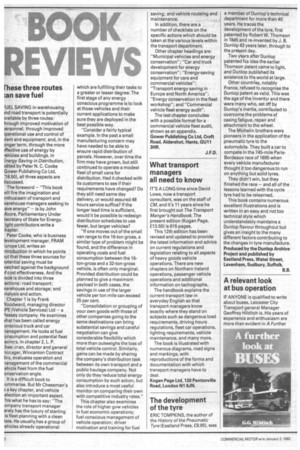rhese three routes an save fuel
Page 12

If you've noticed an error in this article please click here to report it so we can fix it.
:UEL SAVING in warehousing ind road transport is potentially ivailable by three routes: hrough improved motivation of )ersonnel; through improved Terational use and control of )Iant and equipment; and, in the onger term, through the more iffective use of energy by fehicles and building's. In Energy Saving in Distribution, :dited by Peter N. C. Cooke Gower Publishing Co Ltd, :18.50), all three aspects are iiscussed.
The foreword — "This book vill fire the imagination and inthusiasm of transport and varehouse managers seeking to :aye energy" — is by John Aoore, Parliamentary Under iecretary of State for Energy. iight contributors write a ihapter.
Peter Cooke, who is business levelopment manager, FRAM :urope Ltd, writes an ntroduction in which he points iut that these three sources for iotential saving must be vatched against the background if cost effectiveness. And the iook is divided into three .ections: road transport; varehouse and storage; and inalysis and action.
Chapter 1 is by Frank Voodward, managing director >PE (Vehicle Services) Ltd — a 'Iessey company. He examines vhat has been called energy onscious truck and car nanagement. He looks at fuel onsumption and potential fleet avines. In chapter 2, L. P. Thee.Ar.an, director and general nisnager, Wincanton Contract lire, evaluates operation and lanagement of the commercial ehicle fleet from the fuel onservation angle.
It is a difficult book to ;ummarise. But Mr Cheesman's s a key chapter, and vehicle election an important aspect. his what he has to say: "The ompany transport manager arely has the luxury of starting is fleet planning with a clean late. He usually has a group of ehicles already operational which are fulfilling their tasks to a greater or lesser degree. The first stage of any energy conscious programme is to look at those vehicles and their current applications to make sure they are deployed in the best possible way.
"Consider a fairly typical example. In the past a small manufacturing concern may have needed to be able to ensure rapid distribution of parcels. However, over time the firm may have grown, but still continued to operate a modest fleet of small vans for distribution, Had it checked with its customers to see if their requirements have changed? Do they still need same day delivery, or would assured 48 hours service suffice? If the longer lead time is sufficient, would it be possible to redesign distribution schedules to use fewer, but larger vehicles?
"If one moves out of the small van range to the 16-ton gross, a similar type of problem might be found, and the difference in operating costs and fuel consumption between the 16ton-gross and a 32-ton-gross vehicle, is often only marginal. Provided distribution could be planned to give a maximum payload in both cases, the savings in use of the larger vehicle per ton mile can exceed 25 per cent.
"Consolidation or grouping of your own goods with those of other companies going to the same destinations can bring substantial savings and careful negotiation can give considerable flexibility which more than outweighs the loss of total vehicle control. Similarly, gains can be made by sharing the company's distribution task between its own transport and a public haulage company. Not only do they reduce total energy consumption by such action, but also introduce a most useful monitor on comparing their own with competitive industry rates."
This chapter also examines the role of higher gvw vehicles in fuel economic operations; fuel conscious management of vehicle operation; driver motivation and training for fuel saving; and vehicle routeing and maintenance.
In addition, there are a number of checklists on the specific actions which should be taken at the various levels within the transport department.
Other chapter headings are: "Municipal vehicles and energy conservation"; "Car and truck development for energy conservation"; "Energy-saving equipment for cars and commercial vehicles"; "Transport energy saving in Europe and North America"; "Energy conservation in the fleet workshop"; and "Commercial vehicle fleet energy audit".
The last chapter concludes with a possible format for a commercial vehicle fleet audit, shown as an appendix.
Gower Publishing Co Ltd, Croft Road, Aldershot, Hants, GU11 3HR.
J.F.D.














































